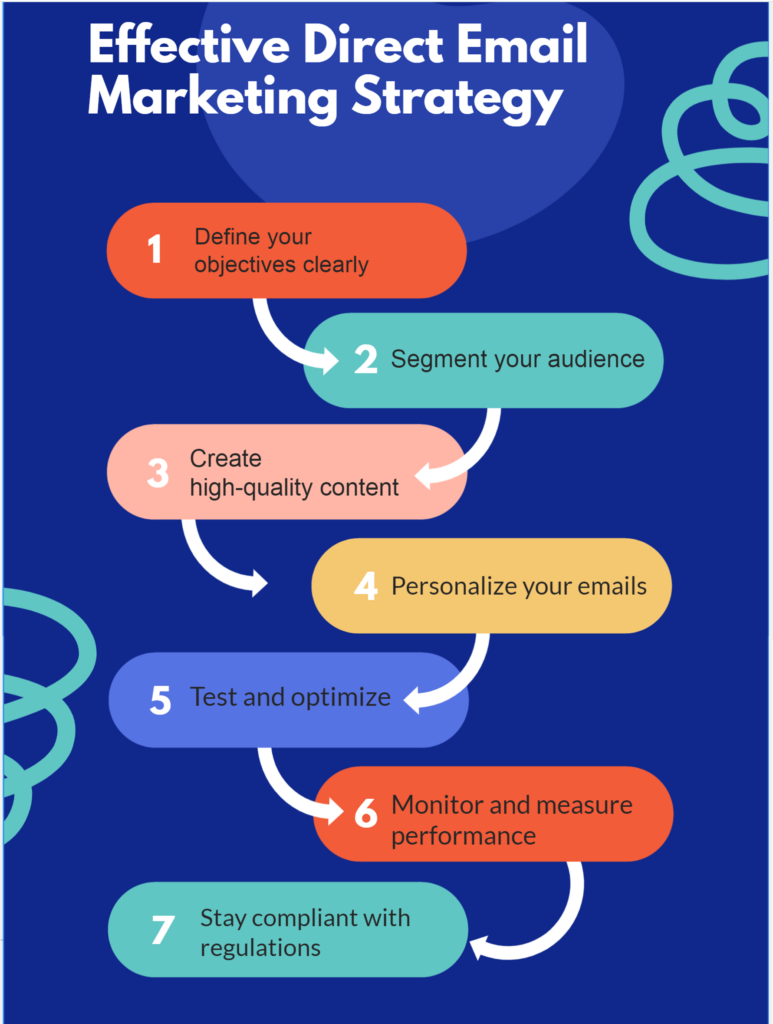- Home
- Fundamentals of Email Marketing
- Direct Email Marketing Explain ...

Direct email marketing is a focused approach within email marketing. It targets direct promotions and sales, while email marketing includes all strategies using email to meet marketing goals. Choosing between general email marketing and direct email marketing depends on your goals, audience, and content strategy.
In this article, we’ll explain how direct email marketing differs from other email strategies and consider the best practices to maximize the effect of your marketing campaigns.
What Is Direct Email Marketing vs. Email Marketing
Direct email marketing and email marketing are closely related terms. But they have nuanced differences when it comes to focus and application. Let’s compare:
- Definition: Direct email marketing is a subset of email marketing. Its primary goal is to promote products, services, or offers directly to the recipient. Direct email marketing is often anticipating an immediate response or action. It focuses on sending promotional messages to either a broad audience or targeted segments, depending on the strategy.
- Scope: The scope of direct email marketing is narrower than general email marketing, as it specifically targets the direct promotion of a product or service.
- Audience: While direct email marketing can target both broad and segmented audiences, the key is that the messages are promotional and aimed at eliciting a direct response.
- Content: The content is more sales-oriented, focusing on offers, discounts, and calls to action (CTA) that encourage the recipient to make a purchase or engage in a similar direct response.
- Objective: The main objective is to drive immediate action, such as sales or leads, through direct promotional messaging.
What Is Direct Email Marketing vs. Direct Response Marketing
In essence, both strategies are about communicating directly with the target audience. However they differ in goals, content strategies, and how success is measured.
You may actually want to use both approaches in your email marketing strategy. It all depends on your objectives and the actions you want your audience to take.
- Scope: Direct email marketing is broader; it aims to engage and inform. Direct response marketing is highly focused on prompting immediate action.
- Objective: The objective of direct email marketing is to build relationships and brand loyalty over time. In contrast, direct response marketing seeks immediate results and conversions.
- Content and CTA: Direct email marketing offers a variety of content not always requiring immediate action. Direct response marketing, however, centers around a compelling CTA to drive specific actions.
- Channels: While direct email marketing is confined to email, direct response marketing employs a broader range of channels.
Do Direct Email Marketing Campaigns Prove Effective?
People receive a lot of emails these days: according to Statista, in 2022, about 333 billion emails were sent and received every day. By 2026, this number is expected to jump to 392.5 billion daily emails.
This makes the effectiveness of almost any email marketing strategy very questionable.
Direct email marketing, with its precise targeting and clear calls to action, stands out as a tool that can cut through the noise.
But just how effective are direct email marketing campaigns really?
Targeting and personalization
Direct email marketing thrives on its ability to target specific segments of an audience with tailored messages.
Advanced data analytics and segmentation techniques let marketers personalize their emails to an unprecedented degree.
This personalization can significantly increase engagement rates – readers are way more likely to respond to content that resonates with what they need or are interested in.
There are lots of studies that say that personalized email campaigns have considerably higher open and click-through rates compared to generic, one-size-fits-all messages.
Immediate and measurable results
One of the most compelling aspects of direct email marketing is its capacity for generating immediate results. This could be a boost in website traffic, a spike in sales, or a surge in event registrations. The impact of a well-written direct email is almost instant.
Another great thing is that every aspect of a direct email campaign can be tracked and measured. This “measurability” gives you a roadmap for continuous optimization and better results.
Cost-effectiveness
Compared to other marketing channels, direct email marketing is remarkably cost-effective. It is affordable for a business of any size: from a large corporation to a small startup. The ROI (return on investment) of email marketing is often cited as one of the highest among digital marketing strategies, making it an attractive option for businesses looking to maximize their marketing budget.
Consumer preferences and behavior
Here’s an interesting thing about email. It has remained a strong staple of online communication – even with all the new interactive online platforms and social media. Even today, most people do check their email every day. This translates into a real opportunity for email marketers when it comes to reaching an audience.
But, the success of direct email marketing depends on how well it’s done. Consumers are picky – and they are particularly picky about which emails they open and read. A successful email offers real value, respects the recipient’s time, and comes from a trusted sender.
Challenges and considerations
Direct email marketing can be very effective, but it’s not always easy.
There are quite a few things that can interfere with the impact of your emails: email overload, spam filters, changing privacy laws, and more.
To make your emailing effective, focus on getting consent from your audience, keeping a clean email list, and adapting to new trends and technology.
Crafting an Effective Direct Email Marketing Strategy

Creating an effective direct email marketing strategy needs a mix of planning, creativity, and data analysis. Know your audience, deliver personalized and engaging content, and keep improving your strategy based on performance data. This approach helps build campaigns that engage your audience and drive conversions.
Define your objectives clearly
The first step towards an effective direct email marketing strategy is to know and define your goals. Are you looking to boost sales? Promote a new service? Re-engage subscribers who seem to have lost interest? Once you’ve set clear, measurable objectives, you will feel more confident in your campaign and will be able to effectively measure its results.
Segment your audience
One size does not fit all in email marketing. Segment your audience based on demographics, purchase history, engagement levels, and other criteria. Tailoring messages to the specific needs and interests of each segment can greatly improve engagement and conversions.
Create good content
The content of your emails is key to their success. Keep your message clear, concise, and compelling. Use strong calls to action to prompt readers to act, whether it’s making a purchase, signing up for a webinar, or downloading a whitepaper. Make sure your content is visually appealing and mobile-friendly, as many users check emails on their mobile devices.
Personalize your emails
Personalization is way more than just starting the email with the right name. It’s about delivering content that matches what your reader is interested in.
Use data analytics to understand what your readers want to know and adjust your strategy accordingly. Personalizing emails makes your recipients feel valued and understood – and they will “repay” you with higher engagement and conversion rates.
Test and optimize
The key to an effective direct email marketing strategy is continuous testing and optimization. A/B testing helps identify which subject lines, email formats, content types, and CTAs perform best. Use these insights to refine your approach and improve your campaigns over time.
Monitor and measure performance
Tracking the performance of your email campaigns is essential to understand their effectiveness and ROI. Monitor key metrics such as open rates, click-through rates, conversion rates, and unsubscribe rates. Analyzing these metrics will provide valuable insights into what works and what doesn’t, enabling you to make data-driven decisions to enhance your strategy.
Stay compliant with regulations
Adherence to email marketing laws and regulations, such as GDPR in Europe and the CAN-SPAM Act in the U.S., is crucial. Ensure that your email marketing practices respect privacy and consent, including clear opt-in procedures and easy unsubscribe options. Compliance not only protects you legally but also helps build trust with your audience.
To Sum Up
Direct email marketing can be a powerful tool. It’s an effective way to build long-term relationships with customers, offer valuable content, and foster brand loyalty.
But to make the most out of your direct email marketing strategy, you need a strategy that works. You will need to plan, stay creative, and analyze data.
Understand your audience, deliver personalized and engaging content, and continuously refine your approach using performance data.



